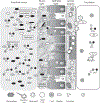Human Milk Oligosaccharides Influence Neonatal Mucosal and Systemic Immunity
- PMID: 28103609
- PMCID: PMC6392703
- DOI: 10.1159/000452818
Human Milk Oligosaccharides Influence Neonatal Mucosal and Systemic Immunity
Abstract
The immune system of the infant is functionally immature and naïve. Human milk contains bioactive proteins, lipids, and carbohydrates that protect the newborn and stimulate innate and adaptive immune development. This review will focus on the role human milk oligosaccharides (HMO) play in neonatal gastrointestinal and systemic immune development and function. For the past decade, intense research has been directed at defining the complexity of oligosaccharides in the milk of many species and is beginning to delineate their diverse functions. These studies have shown that human milk contains a higher concentration as well as a greater structural diversity and degree of fucosylation than the milk oligosaccharides in other species, particularly bovine milk from which many infant formulae are produced. The commercial availability of large quantities of certain HMO has furthered our understanding of the functions of specific HMO, which include protecting the infant from pathogenic infections, facilitating the establishment of the gut microbiota, promoting intestinal development, and stimulating immune maturation. Many of these actions are exerted through carbohydrate-carbohydrate interactions with pathogens or host cells. Two HMOs, 2'-fucosyllactose (2'FL) and lacto-N-neotetraose (LNnT), have recently been added to infant formula. Although this is a first step in narrowing the compositional gap between human milk and infant formula, it is unclear whether 1 or 2 HMO will recapitulate the complexity of actions exerted by the complex mixture of HMO ingested by breastfed infants. Thus, as more HMO become commercially available, either isolated from bovine milk or chemically or microbially synthesized, it is anticipated that more oligosaccharides will be added to infant formula either alone or in combination with other prebiotics.
© 2017 S. Karger AG, Basel.
Figures


Similar articles
-
Human Milk Oligosaccharides: 2'-Fucosyllactose (2'-FL) and Lacto-N-Neotetraose (LNnT) in Infant Formula.Nutrients. 2018 Aug 24;10(9):1161. doi: 10.3390/nu10091161. Nutrients. 2018. PMID: 30149573 Free PMC article. Review.
-
Longitudinal change of selected human milk oligosaccharides and association to infants' growth, an observatory, single center, longitudinal cohort study.PLoS One. 2017 Feb 9;12(2):e0171814. doi: 10.1371/journal.pone.0171814. eCollection 2017. PLoS One. 2017. PMID: 28182762 Free PMC article.
-
Human Milk Oligosaccharides: Factors Affecting Their Composition and Their Physiological Significance.Nestle Nutr Inst Workshop Ser. 2019;90:43-56. doi: 10.1159/000490292. Epub 2019 Mar 13. Nestle Nutr Inst Workshop Ser. 2019. PMID: 30865976
-
Sialylated galacto-oligosaccharides and 2'-fucosyllactose reduce necrotising enterocolitis in neonatal rats.Br J Nutr. 2016 Jul;116(2):294-9. doi: 10.1017/S0007114516002038. Epub 2016 May 23. Br J Nutr. 2016. PMID: 27212112
-
Review of the Clinical Experiences of Feeding Infants Formula Containing the Human Milk Oligosaccharide 2'-Fucosyllactose.Nutrients. 2018 Sep 21;10(10):1346. doi: 10.3390/nu10101346. Nutrients. 2018. PMID: 30241407 Free PMC article. Review.
Cited by
-
3'-Sialyllactose Protects SW1353 Chondrocytic Cells From Interleukin-1β-Induced Oxidative Stress and Inflammation.Front Pharmacol. 2021 Apr 12;12:609817. doi: 10.3389/fphar.2021.609817. eCollection 2021. Front Pharmacol. 2021. PMID: 33912037 Free PMC article.
-
The Human Milk Oligosaccharide 2'-Fucosyllactose Shows an Immune-Enhancing Effect in a Cyclophosphamide-Induced Mouse Model.J Microbiol Biotechnol. 2023 Mar 28;33(3):356-362. doi: 10.4014/jmb.2211.11049. Epub 2022 Dec 13. J Microbiol Biotechnol. 2023. PMID: 36697223 Free PMC article.
-
Early life nutrition.Sci Prog. 2018 Oct 1;101(4):332-359. doi: 10.3184/003685018X15360040523721. Epub 2018 Oct 8. Sci Prog. 2018. PMID: 30296969 Free PMC article. Review.
-
Human Milk Oligosaccharides: Potential Applications in COVID-19.Biomedicines. 2022 Feb 1;10(2):346. doi: 10.3390/biomedicines10020346. Biomedicines. 2022. PMID: 35203555 Free PMC article. Review.
-
Metabolic Fate and Distribution of 2´-Fucosyllactose: Direct Influence on Gut Microbial Activity but not on Brain.Mol Nutr Food Res. 2019 Jul;63(13):e1900035. doi: 10.1002/mnfr.201900035. Epub 2019 Jun 7. Mol Nutr Food Res. 2019. PMID: 31125176 Free PMC article.
References
-
- Walker WA, Iyengar RS: Breast milk, microbiota, and intestinal immune homeostasis. Pediatr Res 2015;77:220–228. - PubMed
-
- Andreas NJ, Kampmann B, Mehring LeDoare K: Human breast milk: a review on its composition and bioactivity. Early Hum Dev 2015;91:629–635. - PubMed
-
- Turfkruyer M, Verhasselt V: Breast milk and its impact on maturation of the neonatal immune system. Curr Opin Infect Dis 2015;28: 199–206. - PubMed
-
- Donovan SM: Role of human milk components in gastrointestinal development: current knowledge and future needs. J Pediatr 2006;149:S49–S61.
Publication types
MeSH terms
Substances
Grants and funding
LinkOut - more resources
Full Text Sources
Other Literature Sources
Medical
Miscellaneous

